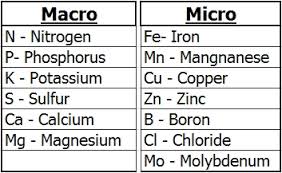What Is NPK fertilizer And How Does It Work?
There are numerous building blocks of life that plants need for healthy growth. Soils often lack these elements, and they need to have them
replenished.
Primary Nutrients: Nitrogen, Phosphorus, and Potassium
NPK fertilizer is primarily composed of three main elements: Nitrogen (N), Phosphorus (P), and Potassium (K), all of these are needed for plant nutrition. Nitrogen helps plants grow quickly, while also increasing the production of seed and fruit and also aids in photosynthesis.
Phosphorus helps with ability of the plant to withstand stress and encourages the growth of roots, and promotes blooming.
Potassium, the third essential nutrient plants demand, assists in photosynthesis, fruit quality, the building of protein, and the reduction of disease.
Secondary Nutrients: Calcium, Magnesium, and Sulfur
While N, P, and K are the most important of the essential elements for plant nutrition, they are by no means the only important elements. Calcium (Ca), magnesium (Mg), and sulfur (S) are second in importance only to nitrogen, phosphorus, and potassium, not because they are less essential, but because smaller amounts of those elements are
- Calcium: Calcium helps roots and leaves grow strong and healthy
- Magnesium: Among its roles in plant growth, magnesium is the central atom in chlorophyll, the molecule responsible for photosynthesis, the process where plants turn sunlight and nutrients into green growth and the life of the plant..
- Sulfur: Sulfur is essential for the production of amino acids, which are the building blocks of proteins found in all living things.
 The third category of essential crop nutrients is called micronutrients. Small But Mighty
The third category of essential crop nutrients is called micronutrients. Small But Mighty
Plants don’t need as much of them as they do primary and secondary fertilizers, but they still can’t do without them. Boron (B), chlorine (Cl), copper (Cu), iron (Fe), manganese (Mn), molybdenum (Mo), nickel (Ni), and zinc (Zn) are essential micronutrients. Of these, boron, copper, zinc, and manganese are most often in short supply in Arizona soils.
- Boron: Boron is essential for healthy cell growth in plants, and is important in the formation of pollen as well. Without pollen, many plants – including most important food and feed crops— would not be able to bear fruit and reproduce..
- Chlorine: Chlorine helps plants manage water stress and may help some plants resist fungal diseases.
- Copper: In plants, copper is important mostly as a catalyst that promotes chemical reactions without becoming part of the product of those reactions. Its indirect role is an important one, though: without it, plants will not develop normally.
- Iron: Like copper, iron serves as a catalyst, especially in the formation of chlorophyll. It also helps regulate certain plant enzymes, and promotes root function.. The leaves of plants deficient in iron often turn pale green or even yellow, a signal that the plant isn’t forming chlorophyll properly.
- Manganese: Manganese is yet another micronutrient that helps plants synthesize chlorophyll, as well as helping regulate several important plant enzymes. Queen Palms in Arizona are most often deficient in this element
- Molybdenum: Molybdenum helps plants make efficient use of nitrogen and phosphorus. Zinc. Zinc plays key roles in human health and nutrition as well as in plants. It helps plants form proteins, starches, and growth hormones, and helps people grow normally and have healthy skin and bones. As with manganese, helping make sure plants have enough zinc helps make sure we have enough, too.
